Exercises for Patellofemoral Pain Syndrome
What is patellofemoral pain?
Patellofemoral pain is a common knee problem. If you have this condition, you feel pain under and around your kneecap. The pain can get worse when you're active or when you sit for a long time. You can have the pain in only one knee, or you can have pain in both knees.
The exact cause of patellofemoral pain isn't known. It probably has something to do with the way your kneecap (called the "patella") moves on the groove of your thigh bone (called the "femur").
What can I do to help my knee get better and hurt less?
- Take a break from physical activity that causes a lot of pounding on your legs, like running, volleyball, or basketball. If you want to keep exercising, try swimming or another low-impact activity. You may want to try working out on nonimpact elliptical trainers, which are popular at gyms. Because these machines support your body weight, they put less stress on your knees. As your knees feel better, you can slowly go back to your normal sports. But do this slowly, and increase the amount of time you do the sports activity by only about 20% a week.
- Do the exercises shown in this handout. Each exercise should take only a few minutes. Doing them twice a day is a good start. Your doctor will tell you which exercises are best for you. The most important ones are usually the first two . These two exercises make your front thigh muscles (called "quads") stronger. This is important because your quad muscles control the movement of your kneecap.
- Talk to your doctor about footwear. It would help to bring your shoes in for the doctor to see. Proper walking or running shoes can help knee pain. Even a simple arch support insert from a shoe store can be helpful. This insert is much less expensive than a custom-made orthotic.
- Ice your knees for 10 to 20 minutes after activity. This can ease the pain and speed up healing. To keep your hands free, use an elastic wrap to hold the ice pack in place. A medicine like ibuprofen (brand names: Advil, Motrin and others) may also help, but talk to your doctor before you take this medicine.
Be patient!
Keep exercising to get better. Patellofemoral pain can be hard to treat, and your knees won't get better overnight. Some people are lucky and get better quickly. But it might take six weeks or even longer for your knee to get better. You'll be less likely to get this pain again if you stay in good shape, but don't make sudden changes in your workouts.
Here are some exercises to help your knee pain. After you do all the exercises as shown in the drawings, reverse your position and do the exercises with your other leg, so both knees get the benefit of stretching.
1. Quadriceps strengthening: isometrics. Position yourself as shown. Hold your right leg straight for 10 to 20 seconds and then relax. Do the exercise 5 to 10 times.
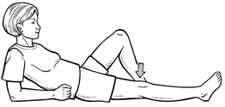
2. Quadriceps strengthening: straight leg lift. Position yourself as shown. Raise your right leg several inches and hold it up for 5 to 10 seconds. Then lower your leg to the floor slowly over a few seconds. Do the exercise 5 to 10 times.
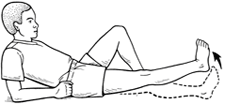
3. Iliotibial band and buttock stretch (right side shown). Position yourself as shown. Twist your trunk to the right and use your left arm to "push" your right leg. You should feel the stretch in your right buttock and the outer part of your right thigh. Hold the stretch for 10 to 20 seconds. Do the exercise 5 to 10 times.
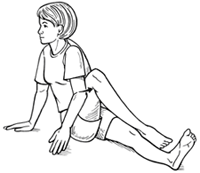
4. Iliotibial band stretch (left side shown). Position yourself as shown, with your right leg crossed in front of your left leg. Hold your hands together and move them toward the floor. You should feel a stretch in the outer part of your left thigh. Hold the stretch for 10 to 20 seconds. Do the exercise 5 to 10 times.

5. Hamstring stretch. Position yourself as shown in the bottom drawing. Bend your left knee. Grip your thigh with your hands to keep the thigh steady. Straighten your left leg in the air until you feel a stretch. Hold the stretch for 5 to 10 seconds. Do the exercise 5 to 10 times.
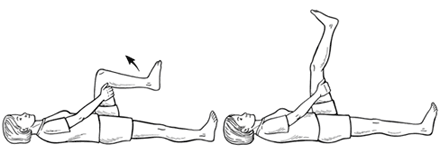
6. Hip adductor strengthening. While sitting, squeeze a rubber ball between your knees. Hold the squeeze for 5 to 10 seconds. Do the exercise 5 to 10 times. (If you don't have a ball, put your hands or fists between your knees and then squeeze.)
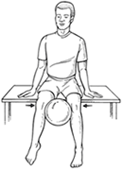
7. Hip abductor strengthening (left side shown, front and side views). Position yourself as shown, standing on your left leg with the knee slightly bent. Slowly raise your right foot about 30 degrees, hold for a few seconds and then slowly lower the foot and straighten both legs. Do the exercise 10 times. Don't let your pelvis tilt (be crooked), and don't let your knees turn inward during bending.
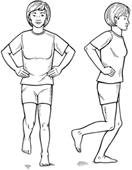
8. Hip and buttock stretch (left side shown). Position yourself as shown, with your left leg over your right leg, and place your hands over your left knee. Pull the knee slightly toward you while sitting up very straight. Hold the position for 20 seconds and then rest for several seconds. Do the exercise 6 times.
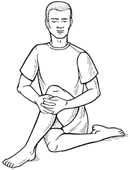
9. Calf stretch. Position yourself against a wall as shown. Keep your left heel on the ground to feel the back leg stretch. Hold for 10 to 20 seconds. Do the exercise 6 to 10 times.
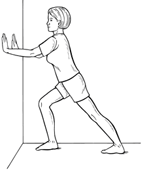
02 9231 0102
Park House Level 3, 187 Macquarie St Sydney NSW 2000
Park House Level 3
187 Macquarie St
Sydney NSW 2000
187 Macquarie St
Sydney NSW 2000



